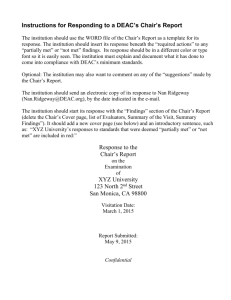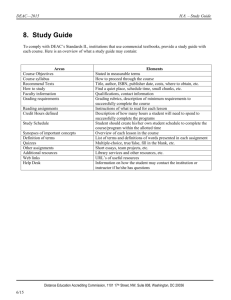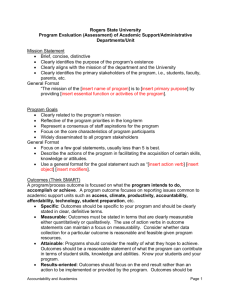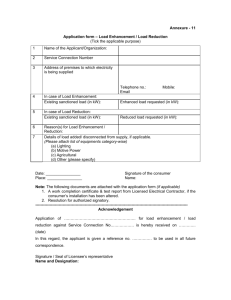Instructions for Progress Report Template
advertisement
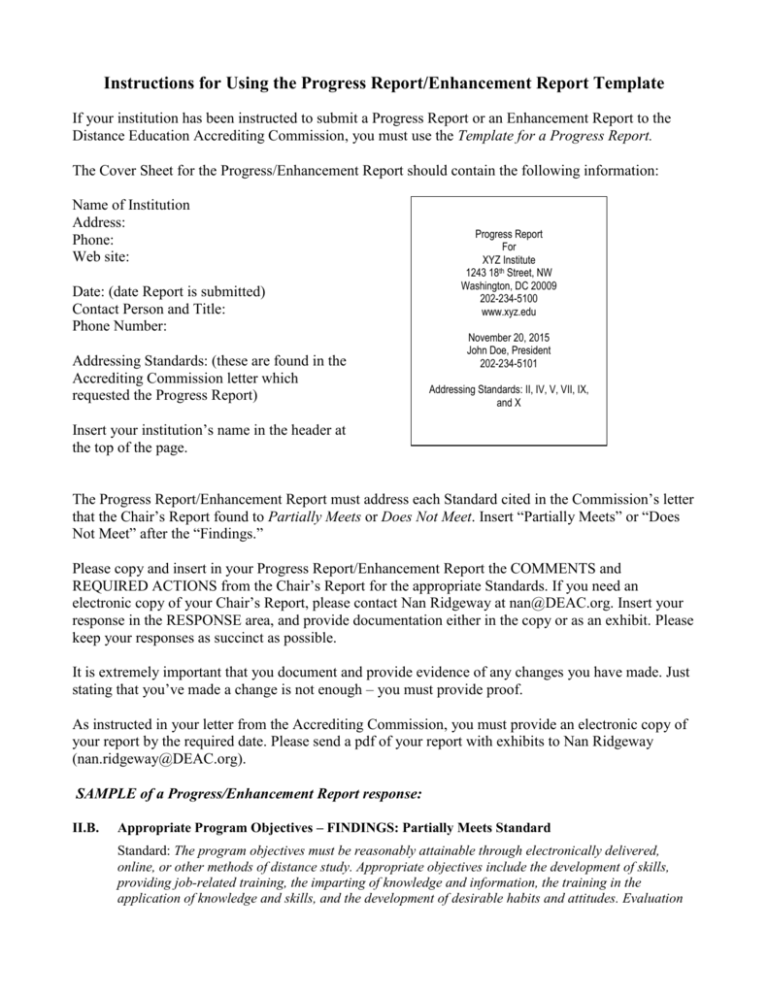
Instructions for Using the Progress Report/Enhancement Report Template If your institution has been instructed to submit a Progress Report or an Enhancement Report to the Distance Education Accrediting Commission, you must use the Template for a Progress Report. The Cover Sheet for the Progress/Enhancement Report should contain the following information: Name of Institution Address: Phone: Web site: Date: (date Report is submitted) Contact Person and Title: Phone Number: Addressing Standards: (these are found in the Accrediting Commission letter which requested the Progress Report) Progress Report For XYZ Institute 1243 18th Street, NW Washington, DC 20009 202-234-5100 www.xyz.edu November 20, 2015 John Doe, President 202-234-5101 Addressing Standards: II, IV, V, VII, IX, and X Insert your institution’s name in the header at the top of the page. The Progress Report/Enhancement Report must address each Standard cited in the Commission’s letter that the Chair’s Report found to Partially Meets or Does Not Meet. Insert “Partially Meets” or “Does Not Meet” after the “Findings.” Please copy and insert in your Progress Report/Enhancement Report the COMMENTS and REQUIRED ACTIONS from the Chair’s Report for the appropriate Standards. If you need an electronic copy of your Chair’s Report, please contact Nan Ridgeway at nan@DEAC.org. Insert your response in the RESPONSE area, and provide documentation either in the copy or as an exhibit. Please keep your responses as succinct as possible. It is extremely important that you document and provide evidence of any changes you have made. Just stating that you’ve made a change is not enough – you must provide proof. As instructed in your letter from the Accrediting Commission, you must provide an electronic copy of your report by the required date. Please send a pdf of your report with exhibits to Nan Ridgeway (nan.ridgeway@DEAC.org). SAMPLE of a Progress/Enhancement Report response: II.B. Appropriate Program Objectives – FINDINGS: Partially Meets Standard Standard: The program objectives must be reasonably attainable through electronically delivered, online, or other methods of distance study. Appropriate objectives include the development of skills, providing job-related training, the imparting of knowledge and information, the training in the application of knowledge and skills, and the development of desirable habits and attitudes. Evaluation of the program is based on the announced objectives and the success with which students achieve the objectives. COMMENTS: (Note: this is copy from the Chair’s Report.) Objectives for the courses and learning modules that make up the degree programs are stated in behavioral terms and are therefore measurable by the assessment vehicles used by the institution. The objectives are reasonably attainable through the distance learning method. Not all program objectives are comparable to those program objectives offered in traditional or other appropriately accredited institutions. Several of the objectives for the Master’s level courses are written at the lower levels of Bloom’s Taxonomy and are therefore not entirely appropriate for courses delivered at the graduate level of university study. As an example, the objectives in the Leadership in Organizations course do not adequately cover the critical content of the graduate level course. REQUIRED ACTIONS: (Note: this is copy from the Chair’s Report.) In the graduate programs, present objectives that require the students to do serious application, analysis, synthesis, and evaluation, written at the higher levels of Bloom’s Taxonomy. RESPONSE: (Note: This is where you insert your response.) The objectives in the course referred to in the Master of Science in Strategic Leadership program, Leadership in Organizations (BUS 545), have been revised and all have been written at upper level Bloom’s Taxonomy to meet DEAC requirements. They are now comparable to other course at regionally and nationally accredited universities. DOCUMENTATION: (Note: this is where you provide your documentation.) Revised Course Objectives for Leadership in Organizations are: Students will be able to: 1. evaluate and categorize leadership and leadership theories 2. compare and contrast different managerial roles and activities required for managers, and how they are changing 3. analyze the three-dimensional model of leadership behavior 4. make inferences about participative leadership, delegation, and empowerment 5. summarize approaches for managing a subordinate who has performance deficiencies 6. explain the process by which power is acquired or lost in organizations 7. outline the relevance of traits and skills in management 8. describe leader effectiveness 9. lead and manage change in a rapidly changing organizational climate 10. compare and contrast the contingency, charismatic, and transformational theories of leadership 11. point out the important guidelines for leading in teams and decision groups 12. critique how coaching, mentoring, action learning, special assignments, simulations, and 360-degree feedback are used for management development 13. evaluate the value of an ethical leadership style 14. describe the most effective leadership styles given different situations These course objectives are comparable to objectives from two other institutions (regional and nationally accredited): University of Phoenix – BUS 587: (list course objectives) American College – BUS 592: (list course objectives)
